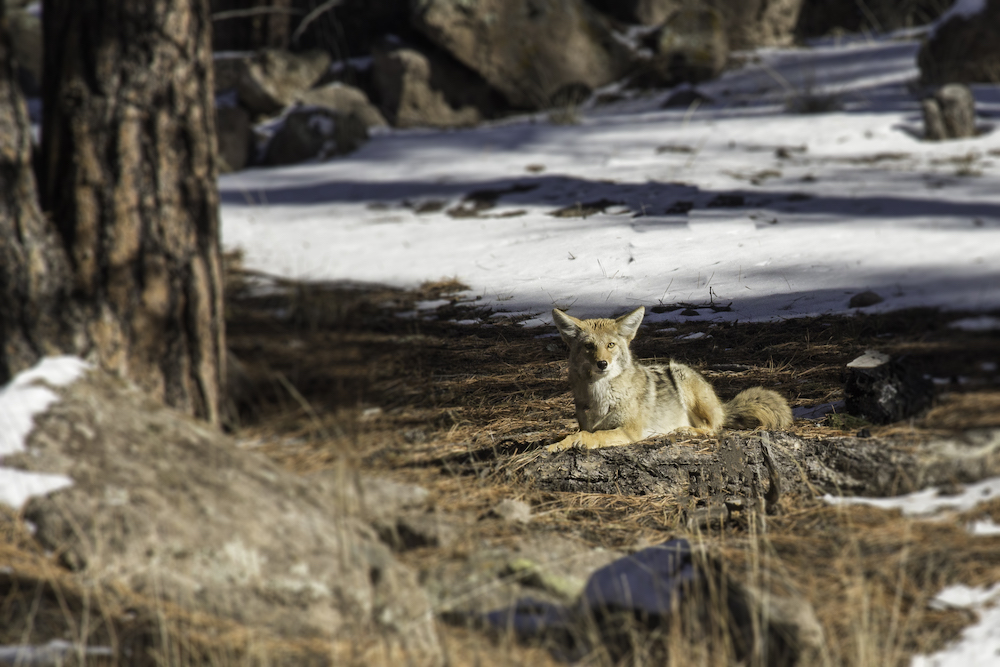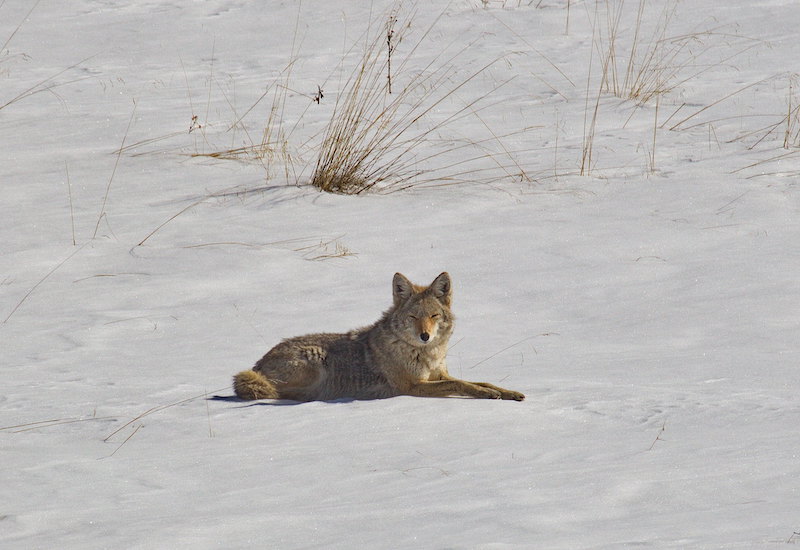
By Mariana Rivera Freeman, Field Science Specialist
In PEEC’s last blog post on coyotes, I discussed the ways we’re inadvertently attracting these opportunistic omnivores through supplemental feeding. In addition to eliminating calorie sources around your home, the best way to keep coyotes off your property is surely to build a fence. We don’t all have the means to afford new property fencing, however; in which case, more accessible exclusion methods can include erecting garden fencing to keep out rabbits (a common prey), replacing exotic tree and shrub species that attract deer (who leave their scent behind), plugging all secret holes and entries into your house to exclude mice and other small mammals, and installing motion-capture lights to startle nighttime visitors.
If you see a coyote passing through your property, it’s okay to enjoy the sight through your window and allow the animal to be on its way. If he or she tends to linger, however, it’s important to take steps to push them along. You can startle them away with pots and pans, sprinklers and hoses, or even just spend more time visibly in your yard (a win-win for everyone). Coyotes in general prefer to avoid humans altogether. The closer they live to humans, in fact, the more nocturnal they become; this says a lot about how much they attempt to avoid us.

A coyote who isn’t afraid of humans is not necessarily “sick” or “unnatural,” but they are exhibiting a level of boldness we should do our best to decondition. In behavioral ecology, we study a concept called the boldness/shyness quotient. A bold individual takes more risks and is likely to live an abbreviated life as a result. Bolder individuals have shorter flight distances when approached by a threat, they’re more likely to be euthanized due to conflict with humans, and are more commonly casualties of roadkill. What, then, is the benefit of choosing boldness over shyness? The answer is in reproductive output, which is often higher for the bold and lower for the shy. While able to enjoy a longer average lifespan, a shy individual struggles more to claim resources against competitors, including mates and territories. If the shy animal lives long enough, they may compensate over the years and be reproductively successful overall; but a long life is never guaranteed. The bolder animal hedges its bets between a shorter life span and more certain reproductive success in a single year. But while boldness provides a genetic and fitness benefit, it can lead to problems on the human-wildlife interface.
Most coyotes will run away at the sight of humans, but you may encounter a bolder coyote who chooses to stand its ground while you’re out on a walk or hike or in your yard. First and foremost, keep in mind that boldness has proven beneficial to that animal thus far, and so it’s crucial to communicate that humans are a particular threat it’s best to be shy about. You want to be loud, big, and scary. The techniques I list below are called hazing. Despite the term, the goal is not to harass the coyote, but rather to resolve the encounter in the best way for both human and animal. The techniques include:
- Maintaining eye contact (do not run as the coyote may reflexively chase)
- Standing tall and waving a stick or other long object
- Keeping children and pets next to you or in your arms
- Taking lunging steps toward the coyote to force it to back away (as in a bluff charge)
- Raising your voice or yelling assertively (do not scream as it signifies distress)
- If all fails, throwing rocks or sticks in the animal’s direction
- And if you have pepper spray at hand (which is recommended), deploying it if necessary
Though rare, coyotes can be aggressive toward domestic animals, children, and even full-grown adults. A common response to such incidents may be a call for killing or relocating the troublesome coyote. In cases of suspected rabies or repeated threats to human safety, euthanizing a single coyote may be the only solution. Attempts to cull a whole population of local coyotes, however, ignores the basic ecological principle of the territorial vacuum. When you remove resident coyotes from their territories, transient coyotes will find the vacuum and establish residence themselves. You now have coyotes you’re not familiar with and who are not familiar with you. This is why culling is ineffective and wasteful.
The key is familiarity. If you are seeing coyotes in your neighborhood, they are likely the same individuals each time. Familiarizing yourself with their habits, routes, and other behaviors provides actionable intelligence. Knowing that a commonly-observed pair, for example, will tend to come through your yard around 6:00 every morning, you may decide to let your dogs out at 7:00 instead. Learn all you can about your coyote neighbors so that you can make decisions as necessary to avoid encounters.
The majority of problems with “nuisance” wildlife are due to human behavior and error. Be proactive in preventing conflict, and you will have more peace of mind to be able to enjoy a sighting or two of coyotes going about their business, whether on the trail or down the road on their way to the next canyon.
